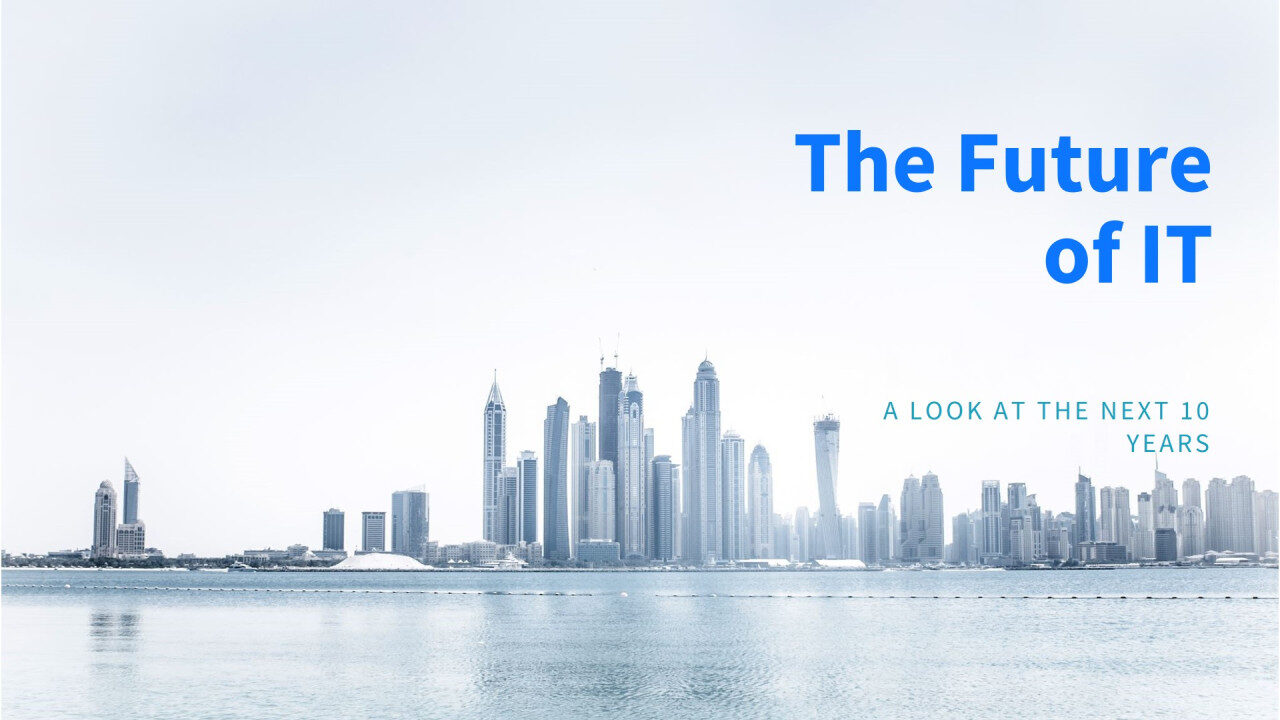

As I wrap up my #30YearsInIT series, it feels only right to take a step back and look ahead toward the future of IT and how it might evolve over the next decade. By the time I reach my 40 Years In IT milestone, I expect we will see profound transformations across the technology landscape, driven by innovation and shifting needs within the Microsoft ecosystem and the broader world of IT. This post is my reflection on the potential of where we might be headed, what technologies and trends could reshape our industry, and how IT professionals must adapt to meet these new challenges.
Over the next decade, I foresee applications becoming even more intuitive, intelligent, and deeply integrated into our day-to-day lives. Today, we are already seeing how Microsoft Copilot and other AI tools are transforming (enhancing???) productivity. By the time I mark #40YearsInIT (yes I will be close to retirement then – Mark), applications will likely become predictive assistants, capable of understanding not just workflows but also proactively anticipating needs. In the Microsoft ecosystem, this means Office tools and platforms like Microsoft Teams may evolve to become highly autonomous, learning user habits and actively suggesting solutions, automating tasks, and even drafting documents without prompting.
For UK businesses, particularly in the Education and Non-Profit sectors, I imagine applications will become the enablers of individualised learning and tailored experiences. Teachers might leverage AI-powered tools that adapt lesson plans to each student’s progress, while charities could automate more of their administrative tasks, allowing them to focus more energy on their causes.
In the Private and Public sectors, integration will be key. Dynamics 365 could become the central nervous system of businesses, connecting every part of an organisation seamlessly, from customer service to sales and from finance to operations, fuelled by AI that analyses and improves processes in real-time. Lets not forget about how the Power Platform will evolve and along with AI, be able to meticulously change the time and effort involved in write documentation, performing data analysis and assisting with Dynamics 365 across the business. Tine saved equals effective cost management equals increased profitability.
When it comes to devices, I expect to see a significant reduction in hardware dependency. The last 30 years have brought us desktops, laptops, smartphones, and tablets. But as I look to the future, I see the rise of wearables, augmented reality (AR) headsets, and perhaps most intriguingly, the concept of invisible interfaces, where physical hardware becomes less of a focus. Devices may not necessarily disappear, but their role will evolve to seamlessly blend into the environment, AR glasses, voice interactions, and gesture-based controls could become commonplace, eliminating the need for traditional screens.
For Microsoft, this might mean expanding Windows beyond a PC operating system into something far more pervasive. Imagine the operating system existing across all devices and experiences, from HoloLens for immersive business collaboration to smart surfaces and even wearable interfaces. In the education sector, this could mean students interacting with learning materials through mixed-reality environments, creating more engaging and practical experiences that far exceed what we have today.
The next ten years will likely see a complete transformation in how IT infrastructure is conceived and managed. Cloud computing will continue to dominate, but the focus will shift more towards hybrid models and edge computing. Edge computing, in particular, will bring the processing power closer to where data is generated, reducing latency and enabling faster, more responsive services. For UK businesses in sectors like Public Services and Healthcare, this will be a game changer, enabling real-time data processing and ensuring compliance with stringent data privacy regulations.
Within the Microsoft ecosystem, services like Azure are already leading this movement, but in the coming decade, I anticipate that Azure will become even more integral. We will see Azure Arc extending the capabilities of Azure to needed (likely to still be required for certain government/global businesses) on-premises, multi-cloud, and edge computing environments, offering consistent security, identity management, and DevOps capabilities across all workloads, wherever they reside. For IT professionals, this evolution will mean shifting skillsets towards managing these distributed, interconnected environments that offer the flexibility of the cloud with the performance of on-premises setups.
Automation will be one of the most significant areas of transformation, impacting every facet of IT, from infrastructure management to user experience. As automation technologies mature, I expect that more and more of the routine, repetitive tasks will be delegated to intelligent bots (or AI agents) and automated workflows. In the Microsoft ecosystem, tools like Power Automate and Logic Apps are paving the way, but ten years from now, these tools could enable a level of operational automation that we can only dream about today.
For instance, business process automation will no longer be something managed solely by IT departments but could be managed by any department user, regardless of technical skills, who will have the tools at their disposal to build and modify workflows, tailor business processes, and automate key tasks without writing a single line of code. This will create opportunities for all sectors, Education, Non-Profit, Public, and Private, to drive efficiency, reduce costs, and improve overall service delivery.
In schools, for example, automation could help reduce the administrative burden on teachers, allowing them to focus more on teaching. In the Non-Profit sector, repetitive tasks like donor management and event planning could be automated, freeing up staff to engage more deeply with their causes. For Public sector organisations, automation could streamline processes like licensing, permitting, and citizen services, enhancing the overall efficiency of governance.
Finally, it’s impossible to discuss the future of IT without acknowledging the role of AI. In ten years, AI won’t just be a tool; it will be the foundation upon which most IT (and not just IT) processes are built. AI will be embedded in applications, infrastructure, and every touchpoint between organisations and their users. For IT professionals, understanding how to integrate AI responsibly, securely, and effectively will be critical.
AI-driven analytics will enable organisations to predict trends, identify risks, and make more informed decisions faster. For example, AI could provide predictive maintenance in infrastructure, flagging issues before they cause outages, or it could drive proactive security, learning normal system behaviour and identifying anomalies before they become breaches.
In the Microsoft ecosystem, AI will play a critical role in everything, from Azure Machine Learning for custom AI models to Microsoft Entra ID for secure identity and access management. The potential for Copilot to evolve beyond an assistant and become an indispensable partner in business, education, and IT operations is enormous. However, with great power comes great responsibility, and ensuring that AI is ethically used and that human oversight remains intact will be paramount as we navigate this new era.
All the posts in this series have taken time for research, thought-provoking reflection, and realignment of my experiences, what has been done, what should be done, and what potentially can be done. Many hours have been spent diving into Microsoft blogs, Microsoft Community posts, Microsoft Learn, as well as content from MVPs and talented individuals from around the globe who have freely posted information, shared videos, and inspired me to say, “Wow.”
The past three weeks of assembling these posts, finalising them, and publishing them have been a challenging but enjoyable journey, full of “head-scratching” moments. The tools that helped bring this series to life include Microsoft Designer, Grammarly, and Microsoft Edge. From revisiting Hyper-V virtual farms to remembering the good times, long days, and rewarding challenges, this experience has reminded me why I am proud to be, as my partner says, Mark V2.0.
The next series is still undecided – it could focus on Mental Health and Well-being (personal to me), or dive deeper into a specific aspect of the Microsoft ecosystem, now I need a glass of Jack Daniels and a little relaxation.
As I conclude this #30YearsInIT series, I am filled with gratitude.
Thank you to everyone I have worked with over the past 30 years, colleagues, clients, mentors, and the many brilliant individuals who have helped shape my journey in IT. To those who have collaborated, supported, and shared in the challenges and successes, you have all made this journey unforgettable.
Looking ahead, I’m excited about what the next 10 years will bring. I am proud to continue my journey as the Modern Workplace Architect and Senior Project Manager at Primary Technology Ltd, and I look forward to helping organisations navigate the evolving IT landscape.
If you are interested in discussing the future of IT or exploring how we can help you embrace these technologies, reach out to us at hello@primaryt.co.uk we’d love to hear from you.
Thank you, and here’s to the next chapter in everyone’s IT journey.
#30YearsInIT #FutureOfIT #Microsoft365 #Azure #DigitalTransformation #ModernWorkplace #AI #Automation #EdgeComputing #PrimaryTechnology #LookingAhead

Microsoft Solution Architect, Senior Project Manager, and Mental Health Advocate